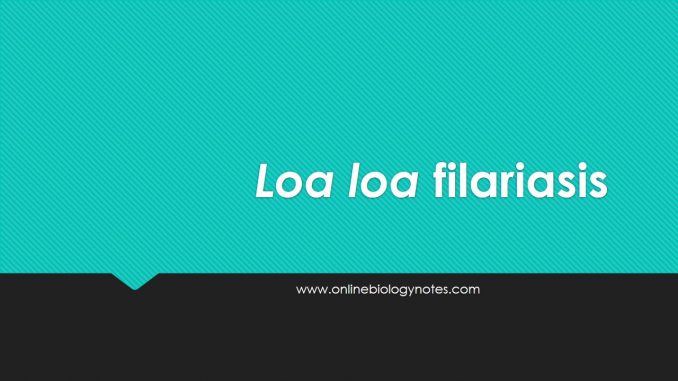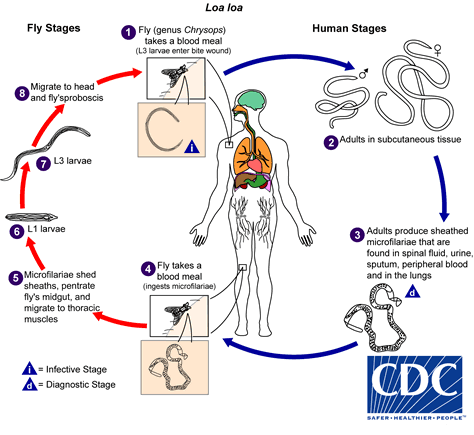
Loa loa filariasis
- Loa loa is a blood dwelling nematode that is parasitic in humans. The adult worm wanders through the subcutaneous tissue but is most obvious as it crosses the conjunctiva of the eye, hence leading to its common name, the African eye worm. It causes loa loa filariasis (loiasis). It is one of three parasitic filarial nematode that causes subcutaneous filariasis in humans.
Habitat
- The adult worm inhibits the subcutaneous tissue of man, often in the sub conjuctival tissue of the eye. The microfilariae are found in blood.
Morphology
Adult worm
- The adult worm are thin, whitish and thread like.
- The anterior and tapers to a narrow head. Surface of the body is covered with small knobs.
- Microscopically the cuticula is found to have numerous rounded protuberances (cuticular bosses) which vary in number and arrangement in two sexes.
- The female worm is 4-7 cm in length and 0.5mm in diameter.
- The life span of worm is 4-12 years.
Microfilaria
- They are found in peripheral blood during day time. Occasionally microfilaria have been demonstrated in the urine, sputum and even CSF.
- Microfilaria is sheathed and measures 250-300 mm in length and 6-8 mm in breadth.
- The column of nuclei extends upto the tail-tip.
- Sheath stains poorly with Geimsa stain but stains well with iron-haematoxylin.
Life cycle of loa loa:
- Loa loa completes its life cycle in two hosts:
- Definitive host: Human
- Man acquires infection by the bite of infected female chrysops. During infection larva enter in large numbers through the punctured wound on the skin made by the fly, during the blood meal.
- The larva enter the subcutaneous tissue and mount to develop into adult worms within a period of 6-12 months.
- Adult worm occasionally migrate in the sub conjunctival tissue.
- The female worm after fertilize by males produce microfilarial larva that circulate in the peripheral blood during the day time and also found in the sub-cutaneous tissue.
- When a female chrysops bites the infected human to suck the blood, microfilaria is ingested that enter the fly’s stomach.
- Microfilarial larvae lose their sheath, penetrate the wall of the stomach and invade thoracic muscles where they undergo changes to form the infective L3 larva.
- Development in fly is completed in about 10 days.
- The mature infective larva than migrate to the mouth parts of chrysops. When this fly bites a new hosts for blood meal, the cycle is again repeated.

Mode of transmission of loa loa:
- Infected man is the only source and reservoir of infection for loa loa.
- Transmission is acquired by the bite of female chrysops species
Pathogenesis and pathology of loa loa:
- Microfilaria are not pathogenic.
- Adult loa loa worms which live in the subcutaneous tissue are pathogenic.
- The migrating adult worms provoke an intense inflammatory reaction.
- Calabar swelling is the typical pathological feature of the loa loa filariasis. It is formed as a result of an allergic response to adult worms migrating in the subcutaneous tissue.
Clinical manifestation of loa loa filariasis:
- Loa loa filariasis (loasis) is the disease produced by adult worm in human.
- The incubation period is on an average 3-4 years.
- Loiasis is asymptomatics in many pcases.
Symptomatic manifestation of loa loa filariasis:
Skin lesions
- Skin lesions consists of colabar swelling or fugitive swelling.
- During migration of the adult worm, it causes oedema of subcutaneous tissues, known as calebur swelling. They disappear in course of 2-3 days and are regarded as allergic reaction of the tissues to filarial toxins.
- Localized pain and itching for several hours usually precede the onset of the swelling. Usually one swelling develops at a time. The swelling is non erythematous, measures 3-10 cm in diameter and last for few days to weeks. The wrist joints or knee joints are most frequently affected. Worms are not usually present in the swellings but are present below surface of the skin.
Ocular lesions
- These consists of;
- Conjunctival granuloma: It is caused by the migration of adult worms in the sub-conjunctival tissues. These granulomas are present as solitary or multiple small nodules measuring 2mm in diameter. These are found in the deeper layers of conjunctiva close to the sclera tissue.
- Oedema of the eyelid: It is painless condition frequently accompanied by itching but not fever or any other constitutional symptoms.
- Proptosis: This condition is known as ‘bug eye’ or ‘bulge eye’ caused by the edema of the orbital cellular tissue. It is a painless condition and of rapid onset frequently associated with itching.
Complications of loasis:
- These include frequent recurrence of fugitive swellings, endomyocardial fibrosis, retinopathy, encephalopathy, neuropathy and arthritis.
- Loa loa meingoencephalopathy is a severe and often fatal complications of infection.
Epidemiology and geographical distribution of loa loa:
- Loiasis is endemic across central Africa. This is widely prevalent in rain forest of both west and central Africa, extending from Sierra leone to Uganda and south ward to Angol. High rate of infection are found in Nigeria, Cameroon and Zaire.
Diagnosis of loa loa:
- Clinical diagnosis is suggested in patients with typical fugitive swellings, high eosinophilia and history of residence in an area endemic for the disease
- Specific diagnosis is made by demonstration and identification of microfilaria in the peripheral blood
- Demonstration of the worm in the cornea or over the bridge of the nose.
- Identification of the adult worm surgically removed from the skin or conjunctiva.
Treatment of loa loa:
- Diethylcarbamazine(DEC) is the drug of choice.
- Dose – 6mg/day, 3 times daily for 12 days
Prevention and control of loa loa:
- Treatment of infected populations
- Using insect repellent
- Wearing protective clothing
- Avoiding visit to the places endemic for the disease
